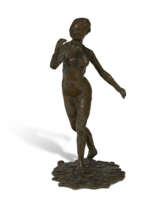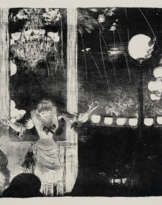ID 1051697
Lot 126 | Edgar Degas (1834-1917)
Estimate value
€ 180 000 – 250 000
Edgar Degas, par lui-même
eau-forte et pointe-sèche avec encre en surface de la plaque partiellement essuyée, sur papier Japon vergé
Plaque: 23 x 14.4 cm.
Feuille: 44.8 x 31.4 cm.
Exécutée en 1857, belle et très rare épreuve du troisième état sur quatre comme décrit par Reed & Shapiro.
etching and drypoint with selectively wiped tone, on laid Japan paper
Plate: 8 x 5 5⁄8 in.
Sheet: 17 5⁄8 x 12 3⁄8 in.
Executed in 1857, a fine and very rare impression of Reed & Shapiro's third state (of four)
Provenance
Étienne Auguste Moreau-Nélaton (1859-1927), Paris.
Galerie Sagot-Le-Garrec, Paris.
Sam Josefowitz, Pully (acquis auprès de celle-ci en 1992).
Puis par descendance aux propriétaires actuels.
Literature
L. Delteil, Le Peintre-Graveur illustré, Degas, New York, 1968, vol. IX, no. 1. iii (notre épreuve citée; une autre épreuve illustrée en frontispice).
J. Adhemar, F. Cachin, The complete etchings, lithographs and monotypes, Londres, 1974, no. 13 (une autre épreuve illustrée).
B. S. Shapiro, S. W. Reed, Edgar Degas: The Painter as Printmaker, cat. ex., Boston, Museum of Fine Arts; Philadelphia Museum of Art; London, Hayward Gallery; Boston, Philadelphia et London, 1984, p. 23, no. 8.iii (une autre épreuve illustrée en frontispice et p. 28).
Degas, Portraits, cat. exp., Kunsthaus Zurich, Kunshthalle Tubingen, Zurich, Tubingen, décembre 1994- juin.1995, p. 16 , no. 30 (une autre épreuve illustrée).
N. G. Stogdon, Edgar Degas 1834-1917, Etchings, Lithographs, Monotypes & Copperplates, Islip, no. 3 (notre épreuve citée; une autre épreuve illustrée).
Degas, A Strange New Beauty, cat. exp., The Museum of Modern Art, New York, 2016, p. 227, no. 2 (une autre épreuve illustrée, p. 55).
S. Lees, R. R. Brettell, Innovative Impressions, Prints by Cassatt, Degas and Pissarro, cat. exp., Tulsa, Oklahoma, juin- septembre, 2018, p. 23 (autres impressions illustrées).
Degas, en noir et blanc, dessins, estampes, photographies, cat. ex., Bibliothèque Nationale de France, Paris, 2023, p. 72, no. 23 (une autre épreuve illustrée, p. 73).
Exhibited
Zurich, Kunsthaus et Tübingen, Kunsthalle, Degas, The Portraits, décembre 1994-juin 1995.
Vevey, Cabinet cantonal des estampes; Quebec, Musée du Québec, Jérusalem, The Israel Museum, Degas & Pissarro, Alchimie d'une rencontre, août 1998-octobre 1999, p. 40, no. 9 (illustrée p. 39).
Further details
Cette importante gravure de jeunesse est le seul autoportrait de Degas imprimé. Le jeune artiste suivait une tradition artistique bien établie, rappelant les autoportraits à l'eau-forte de ses grands ancêtres Rembrandt van Rijn et Sir Anthony van Dyck.
Degas a travaillé Edgar Degas, par lui-même à travers quatre états successifs. Le sujet est entièrement délimité dans le premier état, et dans les états suivants, l'artiste renforce les contrastes de tons avec des couches de hachures croisées pour augmenter l'effet de clair-obscur. Dans le troisième état, dont celui-ci est un bel exemple, des zones de l'arrière-plan ont été rendues rugueuses avec un ton mordoré et la plaque a été sélectivement essuyée avec des quantités variables d'encre de surface, créant un effet qui a été décrit comme "esthétiquement plaisant dans sa lumière et son ombre expressives à la Rembrandtesque" (S. Reed & B. Shapiro, Edgar Degas The Painter as Printmaker, Museum of Fine Arts, Boston, p. 23). Dans le quatrième et dernier état, l'artiste a supprimé une grande partie de ce ton d'arrière-plan, créant un autoportrait plus clair, mais sans l'atmosphère magnifique de l'état précédent.
Les impressions d'Edgar Degas, par lui-même sont rares. Reed & Shapiro a eu connaissance de sept impressions du troisième état, à l'exclusion du présent exemple, dont quatre se trouvent dans des collections publiques, et d'un total de 17 exemples des quatre états, dont 13 se trouvent dans des collections publiques.
This important early etching is Degas's only self-portrait in the print medium. He had first experimented with etching in 1856, and the following year, during a sojourn in Italy, produced this print, emulating the self-portrait etchings of his great ancestors Rembrandt van Rijn, and Sir Anthony van Dyck.
Degas worked Edgar Degas, par lui-même through four successive states. The subject is fully delineated in the first state, and in the following states the artist built up the tonal contrasts with layers of cross hatching to heighten the chiaroscuro effect. In the third state, of which this is a fine example, areas of the background were roughened with a bitten tone and the plate selectively wiped with varying amounts of surface ink creating an effect which has been described as ‘aesthetically pleasing in its expressive Rembrandtesque light and shade’ (S. Reed & B. Shapiro, Edgar Degas The Painter as Printmaker, Museum of Fine Arts, Boston, p. 23). In the fourth and final state the artist removed much of this background tone, creating a clearer self-portrait, but without the magnificent atmosphere of the previous state.
Impressions of Edgar Degas, par lui-même are very rare. Reed & Shapiro were aware of seven impressions of the third state, excluding the present example, four of which are in public collections, and a total of 17 examples across all four states, of which 13 are in public collections.
| Artist: | Edgar Degas (1834 - 1917) |
|---|---|
| Applied technique: | Etching |
| Medium: | Acrylic glass, Plastic |
| Art style: | Impressionism |
| Genre: | Portrait |
| Place of origin: | Western Europe, France, Europe |
| Artist: | Edgar Degas (1834 - 1917) |
|---|---|
| Applied technique: | Etching |
| Medium: | Acrylic glass, Plastic |
| Art style: | Impressionism |
| Genre: | Portrait |
| Place of origin: | Western Europe, France, Europe |
| Address of auction |
CHRISTIE'S 9 Avenue Matignon 75008 Paris France | ||||||||||||||
|---|---|---|---|---|---|---|---|---|---|---|---|---|---|---|---|
| Preview |
| ||||||||||||||
| Phone | +33 (0)1 40 76 85 85 | ||||||||||||||
| Fax | +33 (0)1 40 76 85 86 | ||||||||||||||
| Conditions of purchase | Conditions of purchase | ||||||||||||||
| Shipping |
Postal service Courier service pickup by yourself | ||||||||||||||
| Payment methods |
Wire Transfer | ||||||||||||||
| Business hours | Business hours
|












